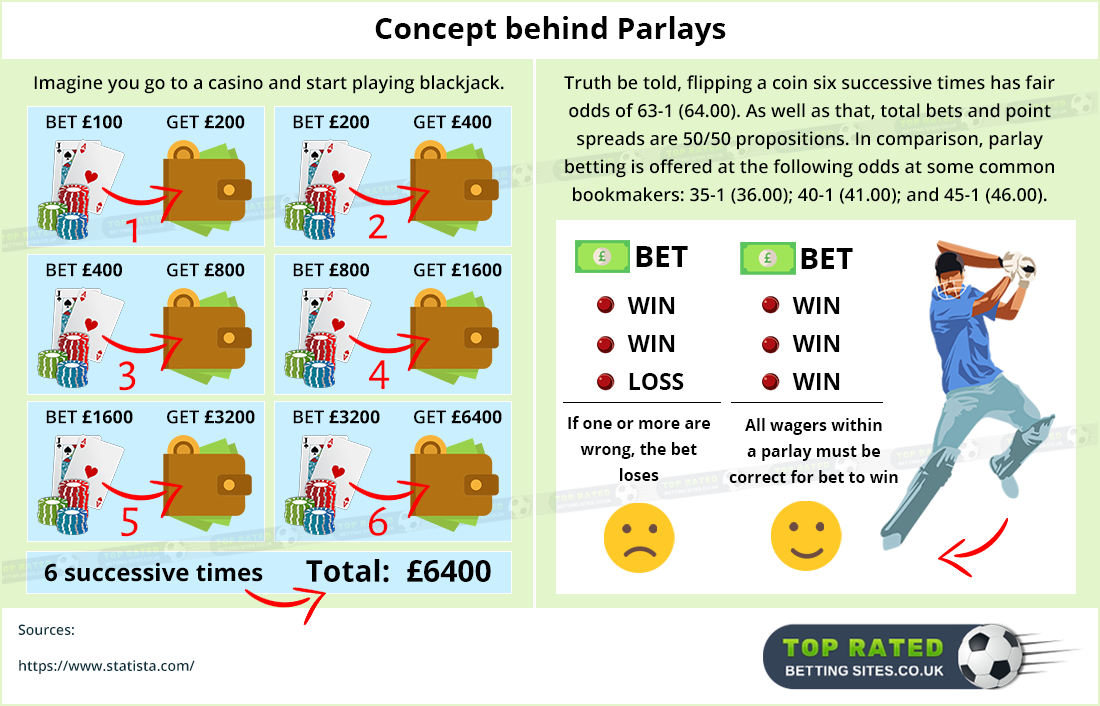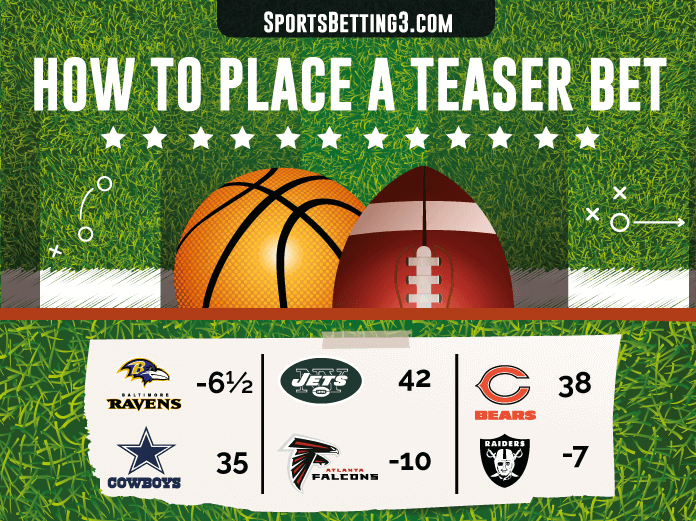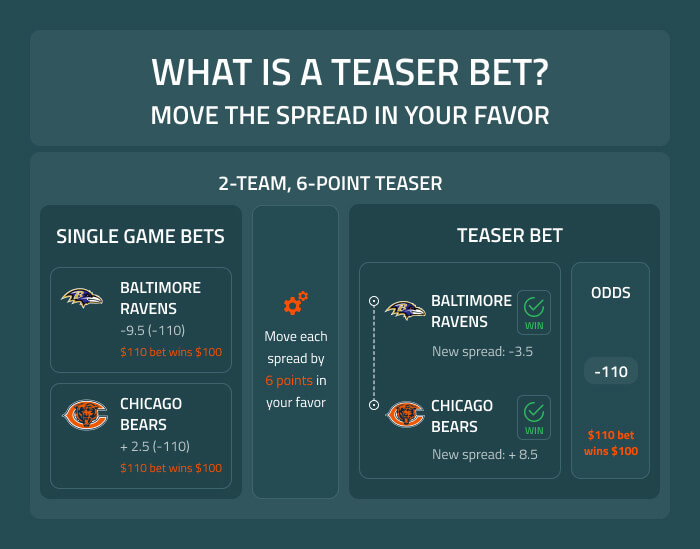Teasers are the most common variant of parlay wager that sportsbooks offer. They allow parlay bettors to mitigate some of the risk that they normally face.
Colorado is soon to become a friendly state for both online and retail sports betting. So, it’s a good idea for new sports bettors in the Centennial State to have an understanding about what this quirky bet is.
Here's an example of how the odds would move on an NFL bet on a 6-point teaser card. In this example, all three favorites are priced above seven points, which is the second most common margin of. For anyone ready to learn, let’s dive into advanced teaser betting which is one the best ways to profit betting NFL football. What is a Teaser Bet. A teaser bet is a parlay bet that uses modified point spreads. For example: a 2-team 6-point teaser on Giants -8.5 -110 and Patriots +4.5 -110 gives you Giants -2.5 and Patriots +10.5 as a parlay. Example of a standard teaser: A teaser involves at least two teams (or totals), and it adds points to each team (or total). Normally 7 points for sides, and 5 points for totals.
How teasers work
In terms of their structure, teasers are identical to parlaywagers. The only thing separating them is a purposeful adjustment of the odds involved.
So, in a teaser, you will combine several wagers into a single bet. Rather than handle each wager individually, the sportsbook will quote you a combined odds payout, just like in parlays.
However, a teaser allows you to shift the sportsbook’s published estimate in your favor. Thus, the chances of a wrong selection decrease.
Teasers usually only apply to point spread and totals (over/under) bets. Adjusting the moneyline is too complicated to work for a teaser.
Teasers are almost always reserved for basketball games, football games, or a combination of the two sports. Adjustments in games with lower scores and lesser expertise is simply not a strategy that most sportsbooks want to undertake.
Why bet on a teaser?
All parlays, including teasers, are risky business. The reason for the high risk is simple, in that every selection, or “leg,” of a parlay must prove correct if a bettor is to be paid.
So, a parlay bettor could wager correctly on 14 straight games, then watch everything fall apart because the 15th selection missed covering by a point. As remarkable as the bettor’s run had been to that point, they would still get the same loss of money.
So, a teaser allows parlay betting but gives each leg a bit more room to breathe. As you put a teaser together, you select a certain number of points to adjust each bet in your favor.
Usually, this adjustment accounts for a 4 – 10 point swing in the spread or over/under. You must apply the same change to all legs across the board, but it will always be to your benefit.
After the shift, each leg will have a shorter distance to climb in order to prove a successful prediction. Thus, the risk of catastrophe decreases dramatically in a teaser.
What’s the catch?
Of course, there are a couple of caveats to teaser bets. The first is that you have to pay for the privilege of reducing the risk.
So, while it is much easier to tease a parlay successfully, it will also pay far less than a standard parlay. Depending on the amount of the adjustment, you could shorten your payout potential to a single percentage of the original parlay payout.
The other catch is that the chance for disaster is still there, and the possibility of losing it all remains in play. Even with a shifted spread or total, a lackluster prediction could spell the end for a parlay bettor, regardless of the variant.
Real world examples of teasers
All this talk of teasers in the abstract might still be a bit difficult to grasp. So, we’re going to give you a few examples of real-world teasers.
These are actual wagers that were available on FanDuel Colorado Sportsbook at one time. The main thing to observe is the discrepancy between the odds of a teaser and a parlay. In every case, we wagered (hypothetically) $100 on the teaser.
2-Team Teaser (NBA)
- Bet 1: Los Angeles Clippers vs. Boston Celtics – LA Point Spread +2 @ -110
- Bet 2: Oklahoma City Thunder vs. New Orleans Pelicans – OVER 234 @ -110
Standard Parlay
Odds: +264
Profit potential: $264.46
Teaser +4
Odds: -110
Profit potential: $90.91
Teaser +4.5
Odds: -120
Profit potential: $83.33
Teaser +5
Odds: -130
Profit potential: $76.92
Comment: Our examples are from basketball. Here, we chose two bets that are both favorites, at least individually. However, as is often the case, you can see that a straight parlay with these choices is still between 2 and 3 to 1 against. The chance of one thing going wrong ruins any security a player might have.
However, all three teaser options give equal or better odds than making individual wagers. Adjusting the spreads or totals by so many points when all else is so equal means that there’s quite a bit of room for error. So, in some cases, a teaser might be able to produce a rather safe overall option. You’ll just have to decide if that’s what you’re after.
5-Team Teaser (College Basketball)


- Bet 1: College of Charleston vs. Hofstra – COC Point Spread +4.5 @ -110
- Bet 2: Memphis vs. Cincinnati – OVER 138 @ -115
- Bet 3: Wichita State vs. Central Florida – UNDER 134 @ -105
- Bet 4: Marshall vs. University of Texas – San Antonio – OVER 163 @ -115
- Bet 5: Arizona vs. California – ARI Point Spread -10 @ -110
Standard Parlay
Odds: +2387
Profit potential: $2387.13
Teaser +4
Odds: +400
Profit potential: $400
Teaser Bet Example Definition
Teaser +4.5
Odds: +350
Profit potential: $350

Teaser +5
Odds: +300
Profit potential: $300

Comment: In this example, the only significant change is the number of legs in the teaser. In fact, there are some odds in these individual bets that are indicative of teams or outcomes that are even more heavily favored. However, as is the case with standard parlays, it is more difficult to win as the number of legs increases. So, a standard parlay with these options is almost a 24:1 underdog.
The teasers aren’t quite so bad, and feature odds between 6 and 8 times shorter than the straight parlay. They’re still longshots, however, so don’t go into them with the expectation of a win. At best, the +5 teaser offers you the option of a 3:1 disadvantage. In other words, you’ll only win that bet 1 out of 4 times. Still, a tripling of profit is a terrific outcome, so it might be worth the risk.

Most Recent Betting Guides
| What is Vig? | How Do Sportsbooks Set Lines? |
| What is Head-to-Head Betting? | NCAAF Rankings vs. Ratings |
| DFS vs. Sports Betting | Difference Between Live vs. Online Betting |
| Are Sports Betting Systems Legit? | What is the Grand Salami Bet? |
Football Teaser Bets
The evil twin of teasers
As it turns out, sportsbooks will sometimes offer a wager that is the exact opposite of a teaser. This bet is known as a pleaser.
So, instead of the bettor gaining an advantage in the wager, the sportsbook receives points back. Pleasers have the effect of increasing the risk of failure from a standard parlay.
Teaser Bet Example Meaning
The notion of taking an already-risky wager like a parlay and lengthening the odds might seem insane on its face. However, the appeal of a pleaser comes from the payout that comes with it.
Where a teaser offers better odds but reduced payouts, a pleaser offers worse odds but better payouts. So, for a bettor who wants to take a shot at a truly outsized score, the pleaser might be exactly what they want.
Pleasers are less-common than teasers, however. It’s not clear why they are less likely to be offered, but if we had to guess, it’s that the sportsbooks already have plenty going in their favor before you spot them any extra points.
Still, if you happen to see an opportunity for a pleaser, and you have some money that you don’t care if you lose, it could be a great opportunity to multiply your stake by several times. Like Dirty Harry might say, it boils down to whether or not you feel lucky.